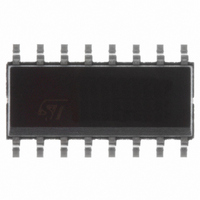M74HC221RM13TR STMicroelectronics, M74HC221RM13TR Datasheet - Page 4

M74HC221RM13TR
Manufacturer Part Number
M74HC221RM13TR
Description
IC MULTIVIBRATR DUAL MONO 16SOIC
Manufacturer
STMicroelectronics
Series
74HCr
Datasheet
1.M74HC221RM13TR.pdf
(14 pages)
Specifications of M74HC221RM13TR
Logic Type
Monostable
Independent Circuits
2
Schmitt Trigger Input
No
Propagation Delay
24ns
Current - Output High, Low
5.2mA, 5.2mA
Voltage - Supply
2 V ~ 6 V
Operating Temperature
-55°C ~ 125°C
Mounting Type
Surface Mount
Package / Case
16-SOIC (3.9mm Width)
Lead Free Status / RoHS Status
Contains lead / RoHS non-compliant
Other names
497-1798-2
M74HC221
BLOCK DIAGRAM
(1) Cx, Rx, Dx are external components.
(2) Dx is a clamping diode.
The external capacitor is charged to Vcc in the stand-by-state, i.e. no trigger. When the supply voltage is turned off Cx is di scharged mainly
trough an internal parasitic diode(see figures). If Cx is sufficiently large and Vcc decreases rapidly, there will be some possibility of damaging
the I.C. with a surge current or latch-up. If the voltage supply filter capacitor is large enough and Vcc decrease slowly, the surge current is
automatically limited and damage to the I.C. is avoided. The maximum forward current of the parasitic diode is approximately 20 mA. In cases
where Cx is large the time taken for the supply voltage to fall to 0.4 Vcc can be calculated as follows :
t
In cases where t
FUNCTIONAL DESCRIPTION
STAND-BY STATE
The external capacitor,Cx, is fully charged to Vcc
in the stand-by state. Hence, before triggering,
transistor Qp and Qn (connected to the Rx/Cx
node) are both turned-off. The two comparators
that control the timing and the two reference
voltage sources stop operating. The total supply
current is therefore only leakage current.
TRIGGER OPERATION
Triggering occurs when :
1 st) A is "LOW" and B has a falling edge;
2 nd) B is "HIGH" and A has a rising edge;
3 rd) A is "LOW" and B is HIGH and C1 has a
rising edge;
After the multivibrator has been retriggered
comparator C1 and C2 start operating and Qn is
turned on. Cx then discharges through Qn. The
voltage at the node R/C external falls.
When it reaches V
C1 becomes low. This in turn reset the flip-flop
and Qn is turned off.
At this point C1 stops functioning but C2 continues
to operate.
4/14
f
> (Vcc - 0.7) x Cx/20mA
f
is too short an external clamping diode is required to protect the I.C. from the surge current.
REFL
the output of comparator
The voltage at R/C external begins to rise with a
time constant set by the external components Rx,
Cx.
Triggering the multivibrator causes Q to go high
after internal delay due to the flip-flop and the
gate. Q remains high until the voltage at R/C
external rises again to V
output goes low and O goes low. C2 stop
operating. That means that after triggering when
the voltage R/C external returns to V
multivibrator has returned to its MONOSTABLE
STATE. In the case where Rx · Cx are large
enough and the discharge time of the capacitor
and the delay time in the I.C. can be ignored, the
width of the output pulse tw (out) is as follows :
RESET OPERATION
CL is normally high. If CL is low, the trigger is not
effective because Q output goes low and trigger
control flip-flop is reset.
Also transistor Op is turned on and Cx is charged
quickly to Vcc. This means if CL input goes low the
IC becomes waiting state both in operating and
non operating state.
tW(OUT) = 0.70 Cx · Rx
REFH
. At this point C2
REFH
the












